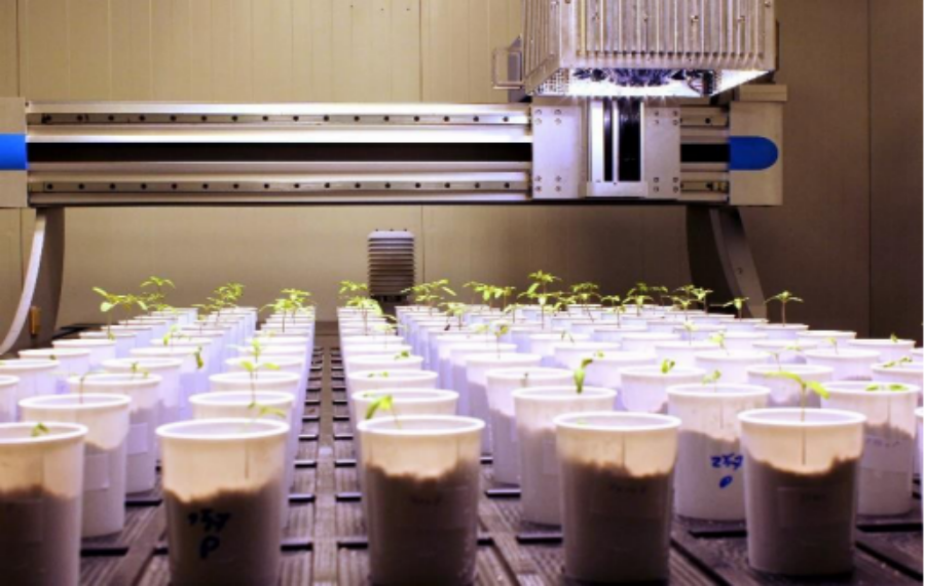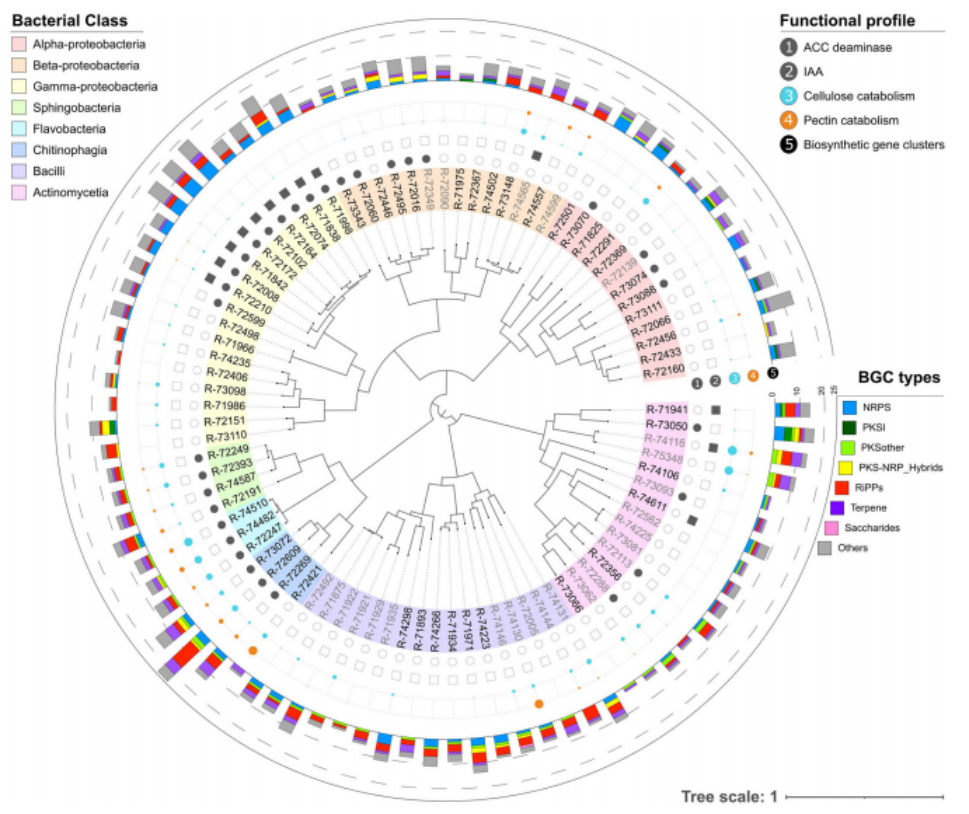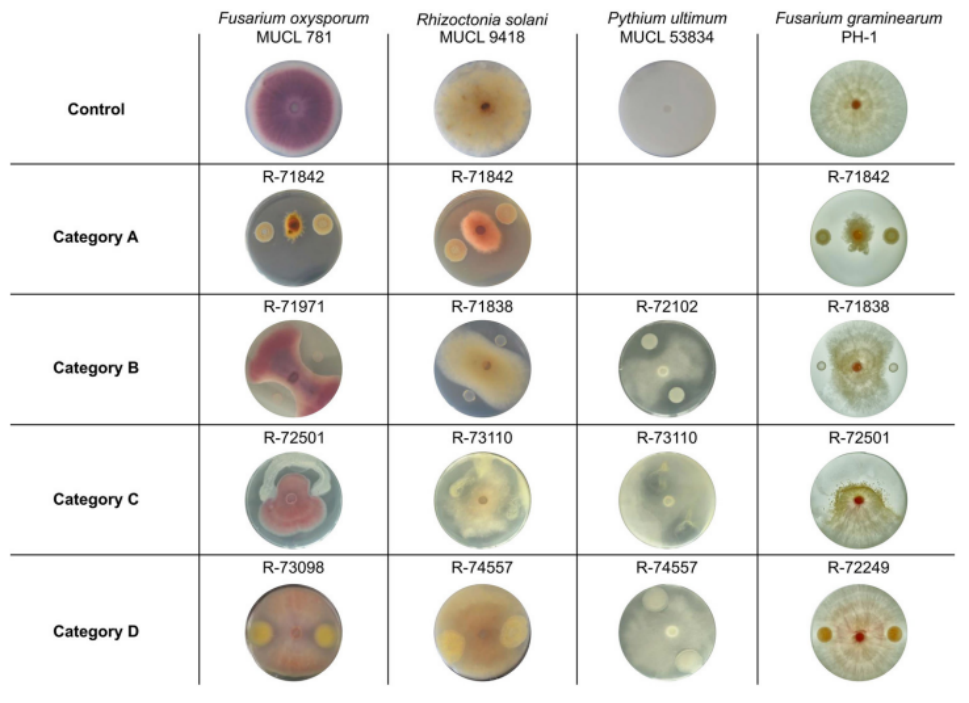品质至上,客户至上,您的满意就是我们的目标
技术文章
当前位置: 首页 > 技术文章
植物表型成像系统WIWAM XY—揭示药用植物根部内生细菌的基因组特征和生物合成基因簇作为鉴定新型生物防治细菌的策略
发表时间:2023-12-18 13:58:37点击:473
来源:北京博普特科技有限公司
分享:
SMO构建WIWAM XY(Pathoviewer)高通量植物表型成像平台
WIWAM植物表型成像系统由比利时SMO公司与GHent大学VIB研究所研制生产,整合了LED植物只能培养、自动化控制系统、叶绿素荧光成像测量分析、植物热成像分析、植物近红外成像分析、植物高光谱分析、植物多光谱分析、植物CT断层扫描分析、自动条码识别管理、RGB真3D成像等多项先进技术,以优化的方式实现大量植物样品以优化的方式实现大量植物样品——从拟南芥、水稻、玉米到各种其它植物的生理生态与形态结构成像分析,用于高通量植物表型成像分析测量、植物胁迫响应成像分析测量、植物生长分析测量、生态毒理学研究、性状识别及植物生理生态分析研究等。

世界人口正在以前所未有的速度增长。农业为不断增长的人口提供食物,正在达到其空间和自然资源的界限。此外,不断变化的立法和生态意识的提高迫使农业减少对环境的影响。这需要用基于自然的解决方案取代农用化学品。在这方面,寻找保护作物免受病原体侵害的有效生物防治剂是人们关注的焦点。在这项研究中,我们研究了从药用植物 Alkanna tinctoria Tausch 中分离的内生细菌的生物防治活性。
为此,最初对大量细菌菌株进行了基因组测序,并进行了计算机筛选,以发现与植物刺激和生物防治相关的特征。基于这些信息,在体外使用平板测定直接拮抗剂和植物分离叶测定法测试了一系列细菌的抗真菌活性。单独和组合测试细菌菌株,以评估最佳治疗效果。结果表明,许多细菌可以产生代谢产物,有效抑制几种真菌的增殖,尤其是禾谷镰刀菌。其中,假单胞菌菌株R-71838在双重培养和植物测定中均表现出较强的抗真菌作用,使其成为最有希望的生物防治应用候选菌。本研究使用来自药用植物的微生物,强调了利用基因组信息来加速筛选具有生物防治能力的分类学多样化细菌的机会
重要性
植物病原真菌是全球粮食生产的主要威胁。预防植物感染的最常见管理措施是大量使用杀菌剂。然而,随着人们对化学品对生态和人类影响的认识不断提高,需要采取替代策略,例如使用细菌生物防治剂。细菌生物防治设计的局限性包括需要劳动密集型和耗时的实验来测试各种菌株,以及它们对病原体的活性缺乏可重复性。在这里,我们表明基因组信息是快速选择目标细菌的有效工具。此外,我们强调菌株假单胞菌属。R-71838在体外和植物中都产生了可重复的抗真菌作用。这些发现为设计基于假单胞菌属R-71838的生物防治策略奠定了基础。
关键词:细菌基因组学、生物防治、次生代谢产物


Uncovering Genomic Features and Biosynthetic Gene Clusters in Endophytic Bacteria from Roots of the Medicinal Plant Alkanna tinctoria Tausch as a Strategy To Identify Novel Biocontrol Bacteria
Abstract
The world’s population is increasing at a rate not seen in the past. Agriculture, providing food for this increasing population, is reaching its boundaries of space and natural resources. In addition, changing legislation and increased ecological awareness are forcing agriculture to reduce its environmental impact. This entails the replacement of agrochemicals with nature-based solutions. In this regard, the search for effective biocontrol agents that protect crops from pathogens is in the spotlight. In this study, we have investigated the biocontrol activity of endophytic bacteria isolated from the medicinal plant Alkanna tinctoria Tausch.
To do so, an extensive collection of bacterial strains was initially genome sequenced and in silico screened for features related to plant stimulation and biocontrol. Based on this information, a selection of bacteria was tested in vitro for antifungal activity using direct antagonism in a plate assay and in planta with a detached-leaf assay. Bacterial strains were tested individually and in combinations to assess the best-performing treatments. The results revealed that many bacteria could produce metabolites that efficiently inhibit the proliferation of several fungi, especially Fusarium graminearum. Among these, Pseudomonas sp. strain R-71838 showed a strong antifungal effect, in both dual-culture and in planta assays, making it the most promising candidate for biocontrol application. Using microbes from medicinal plants, this study highlights the opportunities of using genomic information to speed up the screening of a taxonomically diverse set of bacteria with biocontrol properties.
IMPORTANCE Phytopathogenic fungi are a major threat to global food production. The most common management practice to prevent plant infections involves the intensive use of fungicides. However, with the growing awareness of the ecological and human impacts of chemicals, there is a need for alternative strategies, such as the use of bacterial biocontrol agents. Limitations in the design of bacterial biocontrol included the need for labor-intensive and time-consuming experiments to test a wide diversity of strains and the lack of reproducibility of their activity against pathogens. Here, we show that genomic information is an effective tool to select bacteria of interest quickly. Also, we highlight that the strain Pseudomonas sp. R-71838 produced a reproducible antifungal effect both in vitro and in planta. These findings build a foundation for designing a biocontrol strategy based on Pseudomonas sp. R-71838.